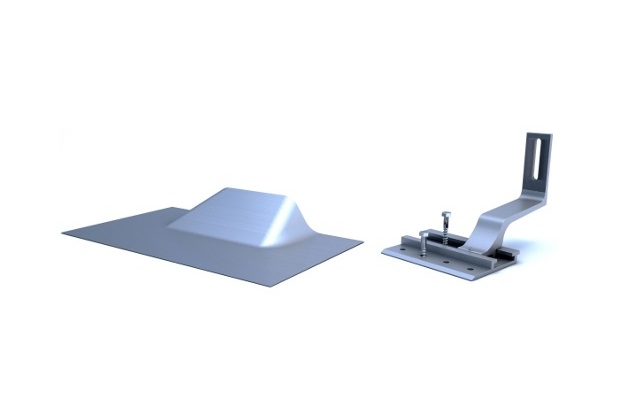The two most common approaches to mounting PV arrays on tile roofs are “standoff” posts and tile hooks. Standoff posts tend to be stronger due to their simple column loading design, while tile hooks use a cantilevered loading configuration (think diving board), which deflects under wind and snow loading. A strong tile hook can be a great solution, and tile hooks have become the most common tile mounting method due to their lower cost, simpler installation process and attractive appearance since most do not need a visible tile level flashing.
However, not all tile hooks are created equally. Tile hooks come in two varieties: 1) structurally robust hooks, which cost a bit more, and 2) inexpensive bent metal steel hooks.
Structurally robust tile hooks are an excellent option for securing a PV array to a tile roof. These hooks typically feature a stiff aluminum cross-sectional design that minimizes cantilever deflection during heavy wind or snow events in an effort to protect against hook-to-tile impact damage. These structurally robust hooks are dimensionally sized to ensure sufficient “serviceability clearance” under the hook.
Inexpensive bent steel hooks have limited upward/downward load capacity. They often sit close to or right on the tile underneath. Even if the hook is adjusted to sit above the tile, these thin bent steel hooks are often too weak to deflect more than 10 to 20 lbs of downforce from causing contact with the tile. When winds reach critical speed, the entire array can chatter on the roof. This chattering noise is alarming and disconcerting to the homeowner, but bigger problems can arise over time as the impact of the weak hooks break tile, allowing excessive rainwater to flow underneath the tile. Since the underlayment is the ultimate waterproofing for a tile roof, this exposure to excessive water can accelerate degradation, ultimately leading to roof leaks.
RELATED: Residential Rooftop Report: How Microflashing leads to solar install savings
Wind driven rain will always find its way uphill between the tile and drip onto the deck, so the official tile flashing requirements found in the Tile Roofing Institute (TRI) Installation manual requires that all penetrations through the roof deck be flashed at the underlayment level. For example, the Quick Hook from Quick Mount PV includes a hooded underlayment flashing which protects the lag screw penetrations from rain water when sealed to the deck using underlayment bibbing or three coursing with asphaltic roofing cement and a reinforcing fabric. Some inexpensive bent metal hooks with vertical height adjustment have sharp corners that rest on the underlayment when adjusted to the fully downward position. These sharp corners dig into the underlayment at the point where the wind driven rain drips down onto the underlayment, and a flashing cannot fix this vulnerability.
Trimming the tile’s weather guard lug is a mandatory step to ensure the tile sits back down in its proper position. Some installers skip the tile trimming process, believing that the thin bent metal hooks are so thin that trimming is not required. However, when the lugs are not trimmed, the tile sits up on top of the tile hook, creating a ½-in. to ¾-in. gap between the tiles. This gap allows even more wind driven rain to reach the underlayment. Trimming the tile lug usually only takes 30-60 seconds using a “tuckpointing” diamond blade on a grinder.
A word of caution: OSHA has recently started enforcing a ban on dry cutting of tile due to silicosis risks. These new regulations regarding silica exposure require wet cutting of tile. To avoid dry cutting, installers are turning to metal Tile Replacement Flashing (TRF), which is a replacement for tile trimming altogether and an easy solution for OSHA compliance. Another benefit of using the TRF is that with every flashing installed, you have a matching tile left over to replace any of the tiles broken during the installation process.
Cutting corners with thin hooks and non-compliant deck waterproofing is a recipe for future leaks. Choosing a strong tile hook and flashing the deck-level penetrations using TRI-compliant flashing methods protects you and your customer’s roof. Your customers will thank you for years of leak-free performance.
Jeff Spies is senior policy director for Quick Mount PV.
— Solar Builder magazine
[source: https://solarbuildermag.com/featured/solar-tile-hook-selection/]

Leave a Reply
You must be logged in to post a comment.